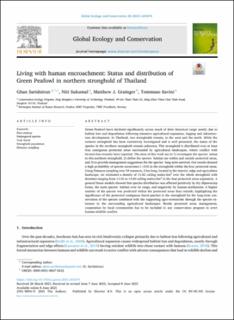| dc.contributor.author | Saridnirun, Ghan | |
| dc.contributor.author | Sukumal, Niti | |
| dc.contributor.author | Grainger, Matthew | |
| dc.contributor.author | Savini, Tomasso | |
| dc.coverage.spatial | Thailand | en_US |
| dc.date.accessioned | 2021-06-17T07:51:12Z | |
| dc.date.available | 2021-06-17T07:51:12Z | |
| dc.date.created | 2021-06-14T13:53:48Z | |
| dc.date.issued | 2021 | |
| dc.identifier.issn | 2351-9894 | |
| dc.identifier.uri | https://hdl.handle.net/11250/2759888 | |
| dc.description.abstract | Green Peafowl have declined significantly across much of their historical range mostly due to habitat loss and degradation following intensive agricultural expansion, logging and infrastructure development. In Thailand, two strongholds remain, in the west and the north. While the western stronghold has been extensively investigated and is well protected, the status of the species in the northern stronghold remain unknown. This stronghold is distributed over at least four contiguous protected areas surrounded by agricultural landscapes, where conflict with farmers has recently been reported. The aims of this work are to 1) investigate the species’ status in this northern stronghold, 2) define the species’ habitat use within and outside protected areas, and 3) to provide management suggestions for the species’ long-term survival. Our results showed a high probability of species occurrence (>0.5) in the stronghold within the four protected areas. Using Distance sampling over 54 transects, 2 km long, located in the interior, edge and agriculture landscape, we estimated a density of 15.82 calling males/km2 over the whole stronghold with densities ranging from 13.55 to 19.89 calling males/km2 in the four protected areas separately. A general linear models showed that species distribution was affected positively by dry dipterocarp forest, the main species’ habitat over its range, and negatively by human settlements. A higher number of the species was predicted within the protected areas than outside, highlighting the significance of the protected contiguous forest patches in the stronghold for the long-term conservation of the species combined with the supporting agro-ecotourism through the species existence in the surrounding agricultural landscapes. Beside protected areas management, cooperation by local communities has to be included in any conservation program to avert human-wildlife conflict. Pavo muticus Endangered species Teak forest Stronghold population Distance sampling | en_US |
| dc.language.iso | eng | en_US |
| dc.rights | Attribution-NonCommercial-NoDerivatives 4.0 Internasjonal | * |
| dc.rights.uri | http://creativecommons.org/licenses/by-nc-nd/4.0/deed.no | * |
| dc.title | Living with human encroachment: Status and distribution of Green Peafowl in northern stronghold of Thailand | en_US |
| dc.type | Peer reviewed | en_US |
| dc.type | Journal article | en_US |
| dc.description.version | publishedVersion | en_US |
| dc.rights.holder | © 2021 The Authors. | en_US |
| dc.subject.nsi | VDP::Zoologiske og botaniske fag: 480 | en_US |
| dc.subject.nsi | VDP::Zoology and botany: 480 | en_US |
| dc.source.volume | 28 | en_US |
| dc.source.journal | Global Ecology and Conservation | en_US |
| dc.identifier.doi | 10.1016/j.gecco.2021.e01674 | |
| dc.identifier.cristin | 1915611 | |
| dc.relation.project | Andre: King Mongkut’s University of Technology Thonburi | en_US |
| dc.source.articlenumber | e01674 | en_US |
| cristin.ispublished | true | |
| cristin.fulltext | original | |
| cristin.qualitycode | 1 | |

